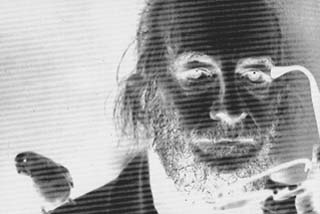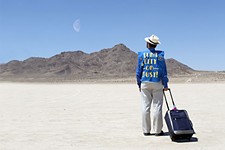A Waking Dream
in*situ Spotlights Harry Smith, Avant-Garde Filmmaker
By Chris Baker, Fri., Nov. 12, 1999

Harry Smith was the beatnik Da Vinci, a voracious intellect who excelled in whatever field caught his interest -- painting, science, film, psychology, math, writing, animation, graphic design, and folklore. He made field recordings of the peyote rituals of Kiowa Indians. He obsessively recorded the sounds outside his window or the dripping of a faucet. He was a consecrated bishop in the Gnostic church. His paper airplane collection, the largest in the world, is currently housed at the Smithsonian. For Smith, who died in 1991 at the age of 68, the common thread that ran through these diverse areas of expertise was the desire to expose interconnections, the recurring themes and patterns and cycles that link vastly different things. As New York Press scribe John Strasbaugh wrote, "It was almost like he was trying to draw the engineering schematics for a unified field theory of the universal soul."
Nowadays, Harry Smith is best remembered for his 1952 Anthology of American Folk Music, a six-record (now 3-CD) compilation of long-forgotten music from the early days of sound recording (circa 1927-1932). Smith's packaging of the Anthology, complete with wry descriptions, scholarly contextualizations, and playfully sophisticated illustrations, has shaped our notion of what albums and liner notes and album art can be. And that is one of the lesser achievements of the compilation. The 84 tracks Smith lovingly assembled and sequenced have had an incalculable effect on American culture and society. The Anthology was the MacGuffey's Reader for the folk revivalists of the Sixties -- most obviously Bob Dylan.
But the 1952 release and 1997 re-release of the Anthology has come to overshadow Smith's 40-year career as a pioneer of avant garde film. This weekend, in*situ -- a collective of sound and visual artists -- will showcase that side of the Renaissance man with Harry Smith: A Re-creation, a collection of Smith's surviving films put together by fellow animator and filmmaker M. Henry Jones. "Harry wasn't only the foremost ethnomusicologist of our century," explains Jones. "He was also the foremost experimental animator and the creator of the multimedia show."
Harry Smith: A Re-creation provides an overview and explication of Smith's body of work. His early nonrepresentational work -- a wash of colors and shapes and textures -- established the "look" of avant-garde film, in which an artist is as likely to draw or paint or scratch directly on the raw negative as to use a camera. It's an artistic method that's influenced many subsequent artists, including Stan Brakhage, the foremost practitioner of this technique.
Smith created his work through a painstakingly intricate frame-by-frame process that utilized everything from batik dye processes to double and triple exposures. His later work incorporated pinhole photography, kaleidoscopic refractions, and brilliant cutout animation that draws upon Max Ernst's collages while prefiguring Terry Gilliam's cartoons for Monty Python.
The cumulative effect is entrancing.
Smith's art aims for the feel of a waking dream. His deep knowledge of mystic ritual and iconography is a vital component in his work; it is also readily apparent that he steeped himself in esoteric subjects such as the Pi phenomenon and persistence of vision, the connotations that different hues and textures conjure in our minds, and (especially) the natural rhythms of pulse, breathing, and even EEG brain waves.
The in*situ "re-creation" even manages to attain a technical complexity that Smith himself never had the opportunity to witness. "There were certain aspects of his work that were not completed simply because he was not able to get as many of these special projectors together," notes Jones. "I was able to put together a show that he would have loved."
It's also reasonable to conclude that Smith would approve of Jones' decision to let cutting-edge figures such as technominimalist DJ Spooky provide musical accompaniment to the program of films (this weekend local trance/dub outfit Futura fill this role). Smith had been fascinated by the interplay of music with his films since the 1940s, when he would project them on the wall at jazz clubs to accompany his favorite musicians. In the Sixties, a fascination with the British Invasion led him to recut his films so they'd sync with the Meet the Beatles album.
The in*situ collective will also play host to artists such as Daniel Johnston, James Highland & Friends, Blue Buckskin Whinchers, and Guy Forsyth, who counts himself among Smith's many fans. ![]()
Harry Smith: A Recreation will be presented by in*situ collective on Friday, November 12, 8pm and Sunday, November 14, 7pm, at Scottish Rite Temple, 207 W. 18th. Tickets are $10 and available at the door or in advance from AusTix, 454-TIXS. For more information, call 452-3809.








